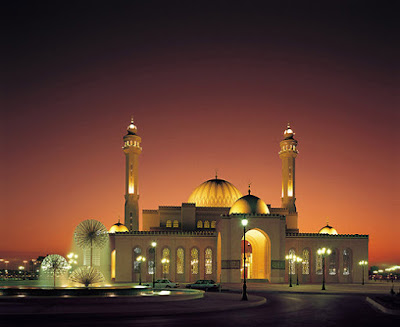Al-Aqsa Mosque (plestine)
Al-Aqsa Mosque (plestine)
Al-Masjid al-Aqsa, is also known as
Al-Aqsa and Bayt al-Muqaddas, is the third holiest site in Islam and is located
in the Old City of Jerusalem. The site on which the silver domed mosque sits,
along with the Dome of the Rock, also referred to as al-Haram ash-Sharif or
"Noble Sanctuary," is the Temple Mount, the holiest site in Judaism,
the place where the Temple is generally accepted to have stood. Muslims believe
that Muhammad was transported from the Sacred Mosque in Mecca to al-Aqsa during
the Night Journey. Islamic tradition holds that Muhammad led prayers towards
this site until the seventeenth month after the emigration, when God directed
him to turn towards the Ka'aba. The mosque was originally a small prayer house
built by the Rashidun caliph Umar, but was rebuilt and expanded by the Umayyad
caliph Abd al-Malik and finished by his son al-Walid in 705 CE. After an
earthquake in 746, the mosque was completely destroyed and rebuilt by the
Abbasid caliph al-Mansur in 754, and again rebuilt by his successor al-Mahdi in
780. Another earthquake destroyed most of al-Aqsa in 1033, but two years later
the Fatimid Caliph Ali az-Zahir built another mosque which has stood to the
present-day. During the periodic renovations undertaken, the various ruling
dynasties of the Islamic Caliphate constructed additions to the mosque and its
precincts, such as its dome, facade, its minbar, minarets and the interior
structure. When the Crusaders captured Jerusalem in 1099, they used the mosque
as a palace and church, but its function as a mosque was restored after its
recapture by Saladin in 1187. More renovations, repairs and additions were
undertaken in the later centuries by the Ayyubids, Mamluks, Ottomans, the
Supreme Muslim Council, and Jordan. Today, the Old City is under Israeli
control, but the mosque remains under the administration of the Palestinian-led
Islamic waqf. The al-Aqsa Mosque is located on the Temple Mount, referred to by
Muslims today as the "Haram al-Sharif" ("The Noble
Sanctuary"), an enclosure expanded by King Herod the Great beginning in 20
BCE. The mosque resides on an artificial platform that is supported by arches
constructed by Herod's engineers to overcome the difficult topographic
conditions resulting from the southward expansion of the enclosure into the
Tyropoeon and Kidron valleys. At the time of the Second Temple, the present
site of the mosque was occupied by the Royal Stoa, a basilica running the
southern wall of the enclosure. The Royal Stoa was destroyed along with the
Temple during the sacking of Jerusalem by the Romans in 70 CE. Emperor
Justinian built a Christian church on the site in the 530s which was
consecrated to the Virgin Mary and named "Church of Our Lady." The
church was later destroyed by Khosrau II, the Sassanid emperor, in the early
7th century and left in ruins. The rectangular al-Aqsa Mosque and its precincts
are 144,000 square metres (1,550,000 sq ft), although the mosque itself is
about 35,000 square metres (380,000 sq ft) and could hold up to 5,000
worshippers. It is 272 feet (83 m) long, 184 feet (56 m) wide dome

